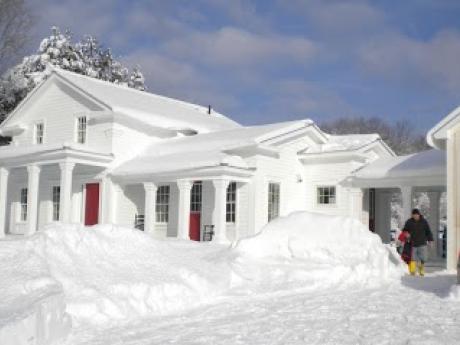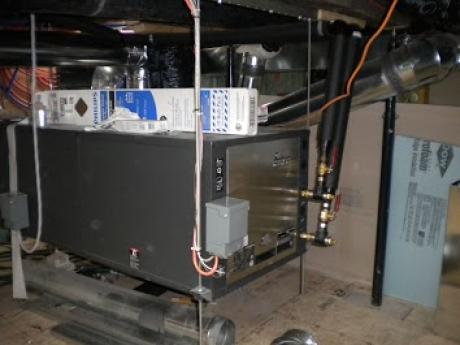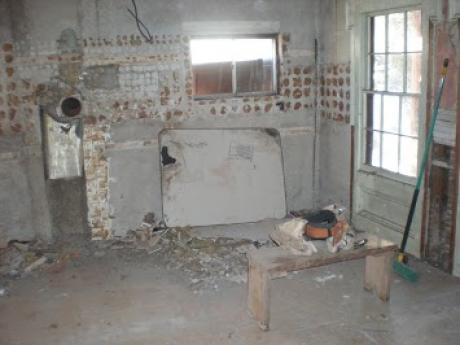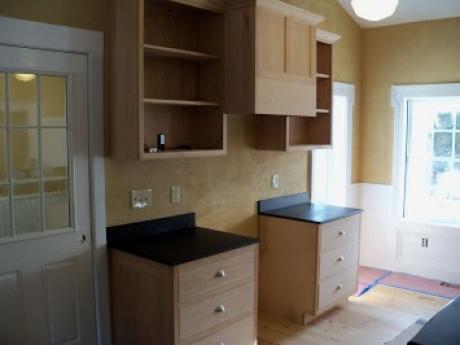1830 Peters - Lockrow House
Renovation of a neglected 1852 Greek Revival
Project Photo Gallery
Project Team
Other Team Members
Owners: Paul & Joanne Coons
Architect: Bart Trudeau, Trudeau Architects, PLLC
Engineer: Dan Hampson, PlumbExcel Engineering
Green Consultant: Karen Totino, Green Conscience
Ratings, Awards and Recognition
Conducting an energy retrofit of our first home, a neglected 1852 Greek Revival, provided us with hands on experience and knowledge. We were looking for a new project and were alerted to a vacant historic 1830 farmhouse. The front of the home faces south and a bike path that leads to our town center is located on the north side of the property. After walking through the dilapidated building we could see the hidden value of the structure. We envisioned it powered 100% by the sun.
We set three goals for the project, to maintain the historic character, make the renovation sustainable and green and provide an energy efficient building.
We started demolition only to find substantial insect, water damage and other structural issues that greatly increased the scope of work. Our architect incorporated the newly found damage as well as other ideas from the Building Science Corporation book “Builders Guide to Cold Climates” by Lstiburek and ideas from the book “Prescriptions for a Healthy House” by Baker-Laporte, Elliott and Banta.
We built new partitions inside the existing exterior walls using offset studs, allowing us to increase the insulation, as well as provide a thermal break. The new wall cavities were filled with approximately 8” of closed cell foam. After replacing the second story roof structure (inadequate for the expected snow loads) we filled the rafter spaces with closed cell spray foam, covered the decking with a recycled rubber roof underlayment, 4 inches of Styrofoam insulation, and finally a standing seam metal roof.
The design required us to preserve the existing room layout and south facing facade of the building. We renovated the facade by reinstalling wood siding, rebuilding the porches, existing double hung windows and wooden storms. In addition, we installed magnetic interior storm windows over the existing windows to increase their energy efficiency.
Care was taken in choosing systems and products for energy reduction as well as local sourcing to reduce our construction and operating carbon footprint.
Quick Facts
General
Location
Clifton Park, New York
Building Type
single-family residence
Project Type
Zero Energy Ready / Near Zero Energy
Basis of Performance Claim
Verified
Bedrooms
3
Bathrooms
2.5
Total Cost of Project
$288,000
Energy Summary
Energy Data Type
Verified
Renewable Energy System Type(s)
Photovoltaics, Geothermal, Other
Ratings
NYS Energy Star
LEED Platinum Certification 2011
HERS Index
7
Net electricity usage (purchased)
14 kWh/year
Annual renewable energy generated
9,983 kWh/year
Envelope and Mechanicals
Subslab assembly
Sub slab: dirt crawl spaces with two inches of Styrofoam under a plastic liner conditioned mechanical space basement with Anvantech flooring over two inches of Styrofoam and Patton polyethylene sheets
Foundation wall assembly
Existing, R-40 (rater indicates R-15) 8“ of closed cell foam over plastic wall liner with offset steel studs and covered with paperless drywall
Addition, R-20 (rater indicates R-23) 8“ of sprayed closed cell foam over continuous plastic wall
Above grade wall assembly
Existing, R-56 (rater indicates-47) offset wall studs with 8“ sprayed closed cell foam
Addition, R-52 off set wall studs with 8” of closed cell foam
8” double offset stud wall new addition and all existing exterior walls to offset thermal bridging and increase depth of foam insulation
American Clay over existing plaster or new wall board throughout
Door Assembly
The new doors are made by Thermo-Tru and are Energy star rated with a U value of 0.26 and a SHGC of 0.17
Air Changes per hour, ACH50
2.54 ACH50
Project Photo Gallery
Project Team
Other Team Members
Owners: Paul & Joanne Coons
Architect: Bart Trudeau, Trudeau Architects, PLLC
Engineer: Dan Hampson, PlumbExcel Engineering
Green Consultant: Karen Totino, Green Conscience
Ratings, Awards and Recognition
Conducting an energy retrofit of our first home, a neglected 1852 Greek Revival, provided us with hands on experience and knowledge. We were looking for a new project and were alerted to a vacant historic 1830 farmhouse. The front of the home faces south and a bike path that leads to our town center is located on the north side of the property. After walking through the dilapidated building we could see the hidden value of the structure. We envisioned it powered 100% by the sun.
We set three goals for the project, to maintain the historic character, make the renovation sustainable and green and provide an energy efficient building.
We started demolition only to find substantial insect, water damage and other structural issues that greatly increased the scope of work. Our architect incorporated the newly found damage as well as other ideas from the Building Science Corporation book “Builders Guide to Cold Climates” by Lstiburek and ideas from the book “Prescriptions for a Healthy House” by Baker-Laporte, Elliott and Banta.
We built new partitions inside the existing exterior walls using offset studs, allowing us to increase the insulation, as well as provide a thermal break. The new wall cavities were filled with approximately 8” of closed cell foam. After replacing the second story roof structure (inadequate for the expected snow loads) we filled the rafter spaces with closed cell spray foam, covered the decking with a recycled rubber roof underlayment, 4 inches of Styrofoam insulation, and finally a standing seam metal roof.
The design required us to preserve the existing room layout and south facing facade of the building. We renovated the facade by reinstalling wood siding, rebuilding the porches, existing double hung windows and wooden storms. In addition, we installed magnetic interior storm windows over the existing windows to increase their energy efficiency.
Care was taken in choosing systems and products for energy reduction as well as local sourcing to reduce our construction and operating carbon footprint.
Quick Facts
General
| Location | Clifton Park, New York |
|---|---|
| Building Type | single-family residence |
| Project Type | Zero Energy Ready / Near Zero Energy |
| Basis of Performance Claim | Verified |
| Bedrooms | 3 |
| Bathrooms | 2.5 |
| Total Cost of Project | $288,000 |
Energy Summary
| Energy Data Type | Verified |
|---|---|
| Renewable Energy System Type(s) | Photovoltaics, Geothermal, Other |
| Ratings |
NYS Energy Star |
| HERS Index | 7 |
| Net electricity usage (purchased) | 14 kWh/year |
| Annual renewable energy generated | 9,983 kWh/year |
Envelope and Mechanicals
| Subslab assembly |
Sub slab: dirt crawl spaces with two inches of Styrofoam under a plastic liner conditioned mechanical space basement with Anvantech flooring over two inches of Styrofoam and Patton polyethylene sheets |
|---|---|
| Foundation wall assembly |
Existing, R-40 (rater indicates R-15) 8“ of closed cell foam over plastic wall liner with offset steel studs and covered with paperless drywall |
| Above grade wall assembly |
Existing, R-56 (rater indicates-47) offset wall studs with 8“ sprayed closed cell foam 8” double offset stud wall new addition and all existing exterior walls to offset thermal bridging and increase depth of foam insulation |
| Door Assembly |
The new doors are made by Thermo-Tru and are Energy star rated with a U value of 0.26 and a SHGC of 0.17 |
| Air Changes per hour, ACH50 | 2.54 ACH50 |





